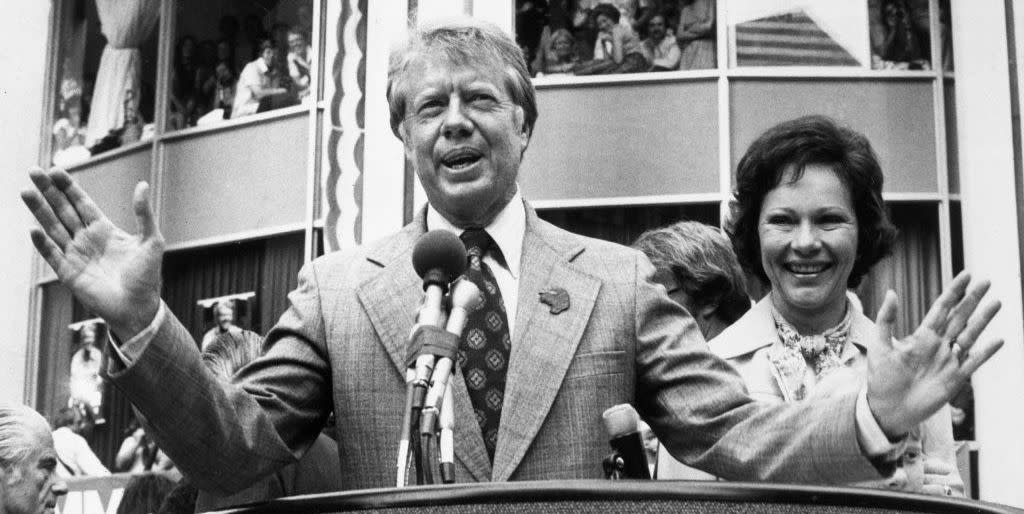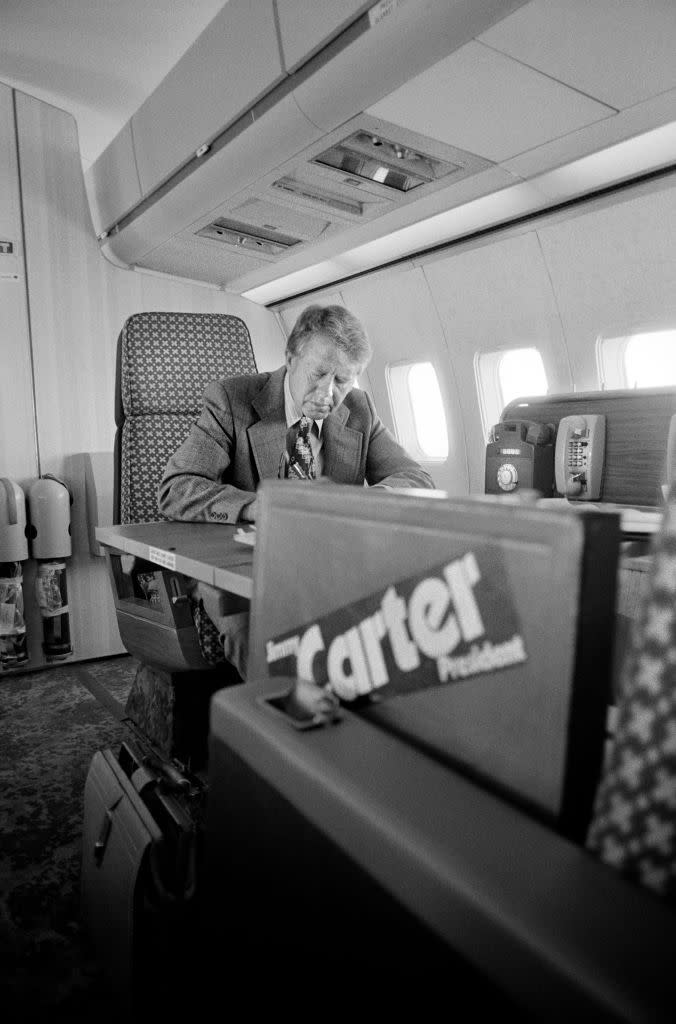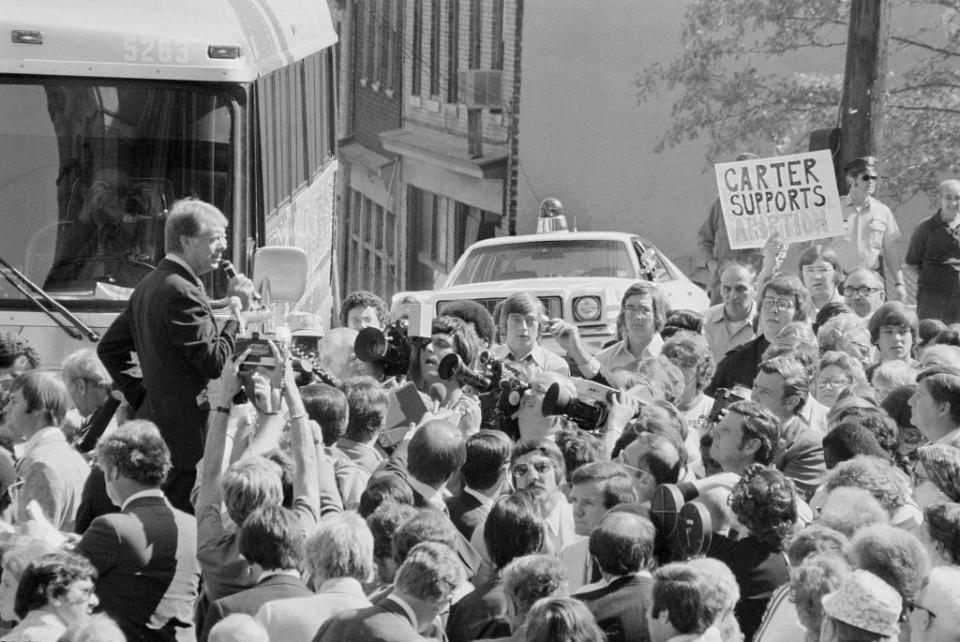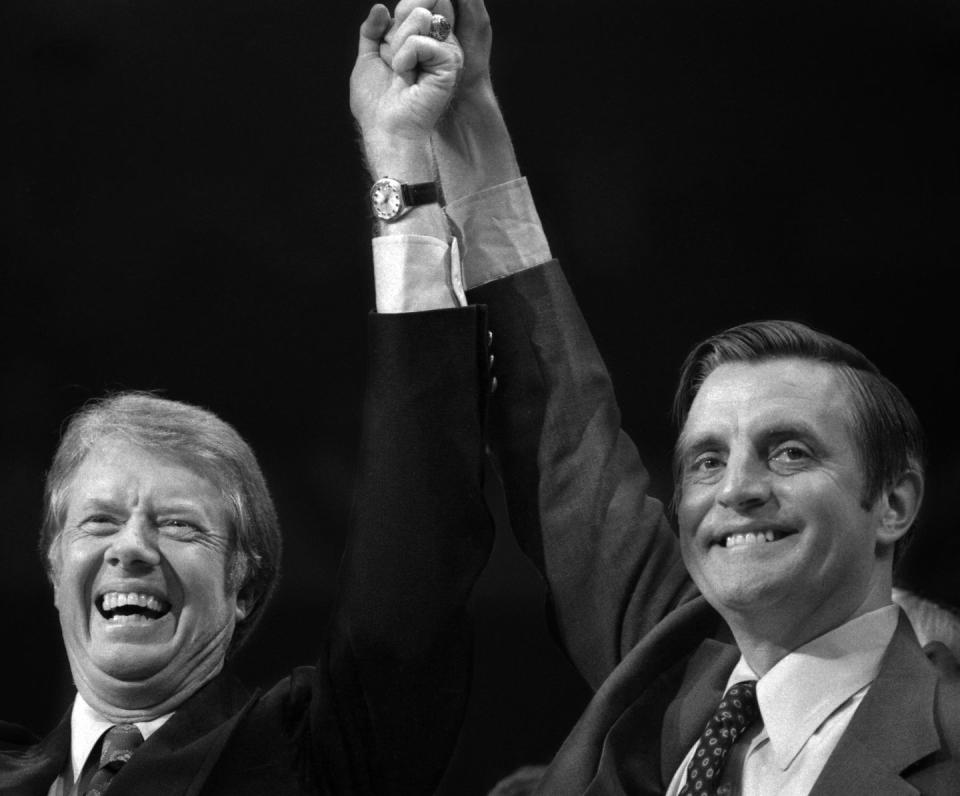Nobody Thought Jimmy Carter Had a Chance in the Presidential Primary. Here’s How He Won It.

- Oops!Something went wrong.Please try again later.
- Oops!Something went wrong.Please try again later.
- Oops!Something went wrong.Please try again later.
"Hearst Magazines and Yahoo may earn commission or revenue on some items through these links."
A one-term former governor and peanut farmer from Georgia, Jimmy Carter was hardly the front-runner heading into the 1976 presidential election. He tied for 12th in early polling among a crowded slate of possible Democratic primary candidates, which included well-established national figures like Massachusetts Senator Ted Kennedy and Alabama Governor George Wallace.
Carter was not very well-known outside of Georgia and neighboring southern states. Pundits thought he had no chance, and newspapers gave him little coverage. Many felt a Southerner couldn’t win a national election, and he had no power base in Washington, where one establishment bigwig was overheard at a cocktail party saying, “He can’t be the President; I don’t even know him!” according to Carter biographer Kai Bird.
Yet when the Democratic Party presidential primaries were over, Carter came away with a massive lead in delegates, winning 2,239 compared to Wallace’s 57 and California Governor Jerry Brown’s 301. He decidedly captured his party’s nomination on July 15, 1976.
How did he go from a long-shot dark horse to his party’s choice for presidential candidate? As is often the case with electoral victories, it was a combination of factors. Carter benefitted from hard work, a shrewd campaign strategy, and an electorate hungry for an outsider candidate following the Vietnam War and Watergate scandal. His victory also came during a time of new campaign finance laws and a revised primary election system that Carter and his team understood better than any of the other candidates.
“Carter benefitted immeasurably from the unique circumstances in the elections of 1976,” Peter Bourne wrote in his book Jimmy Carter: A Comprehensive Biography from Plains to Post-Presidency. “It is unlikely that he could have succeeded in any other year.”
An Early Start

Carter’s presidential ambitions began far earlier than many people realized. He was sworn in as the 76th governor of Georgia in January 1971. But by as early as 1972, he was already trying to position himself as a possible vice presidential pick in that year’s national election, according to Kai Bird’s book The Outlier: The Unfinished Presidency of Jimmy Carter.
After Republican candidate Richard Nixon trounced Democratic challenger George McGovern, Carter began having conversations with a small group of confidants about running in 1976. Bird wrote that after one such meeting, Gerald Rafshoon, who later became Carter’s White House communications director, commented: “That son of a b—, he wants it.”
Hamilton Jordan, Carter’s longtime political operative and future White House chief of staff, wrote a 70-page memo laying out how Carter could win in 1976, even in a crowded field. By Christmas 1972, Carter was telling his family that he planned to run for president. His mother, Lillian Gordy Carter, skeptically responded, “President of what?,” according to Bird.
An Outsider’s Campaign
Jordan stressed that voters would be craving an outsider candidate due to their disillusionment with government following the Vietnam War and Nixon’s Watergate scandal and subsequent resignation. Carter kept his distance from the Washington establishment, choosing Atlanta, rather than the nation’s capital, as his campaign headquarters, according to Bourne’s book.
Critics alleged that Carter avoided specifics on policy positions and instead ran on his life story and a populist, anti-establishment persona. He cultivated an image of honesty and integrity, promising voters: “I’ll never lie to you.” According to Bird, longtime advisor Charles Kirbo admonished Carter, only half-jokingly: “You’re going to lose the liar vote.”
With few pundits taking him seriously at first, Carter traveled constantly and often slept on the couches of local supporters during campaign stops. According to Bourne, Carter rented a large hotel ballroom with enough food for hundreds of people during a campaign reception in Des Moines, Iowa, and only four people showed up. “I stood around embarrassed,” Carter said.
Lacking a national fundraising machinery like his opponents had, Carter had to “grub for every penny,” Bourne wrote. Members of his own family had to seek donations for him. His son Chip would literally stop people on the street and say: “My daddy is running for President, and would you give him $10?”
Carter also had to overcome biases against Southerners in national races, particularly from the Washington establishment. Bird wrote: “The accent grated on their ears. The image of the peanut farmer brought on a smirk. If he came from southern Georgia, [they thought] he must be conservative, and if Carter himself seemed intelligent … well, his entourage of rednecks were not so smart.”
A Winning Strategy

But the presidential election process underwent changes prior to 1976, and Carter and his team understood the potential of the new battleground better than his opponents. That year’s election saw a move away from old boss-dominated nominating systems and a larger number of primaries and caucuses.
Under one new rule, delegates in primary states were chosen by congressional district, with candidates who got 15 percent or more of the popular vote receiving a proportional amount of delegates, Bourne wrote. In the past, candidates could get by capturing a few big winner-take-all states, but Carter’s strategy focused on passing that 15 percent threshold in a large number of states and amassing delegates across all of them.
“Several candidates who would beat Carter in the popular vote would come away with fewer delegates from a state because they had not grasped the full significance of the new ‘democratized’ rules,” Bourne wrote.
Carter also benefited from new legislation after Watergate that established public financing for presidential elections, Bourne said. Additionally, individual contributions were limited to $1,000, which benefitted the grassroots campaign of Carter, who did not have wealthy backers and depended largely on small amounts of money from ordinary citizens. “For the first time, dark horse candidates were competing on an equal footing with national figures,” Bourne wrote.
Just like Hamilton Jordan recommended in his 70-page memo four years earlier, Carter concentrated on achieving early wins in the Iowa caucus and New Hampshire primary. Soon, The New York Times was touting the previously little-known Carter as the front-runner.
By then, more money was pouring into his campaign, and he was easily surpassing the 15 percent threshold in every primary race while other candidates—who were slower in coming around to Carter’s strategy—were forced to pick and choose the remaining states in which they were most competitive.
A Remarkable Victory

By the time the 1976 Democratic National Convention took place in July, the result was a foregone conclusion. Jimmy Carter took the stage at New York City’s Madison Square Garden, and the one-time underdog accepted his party’s nomination for president.
The New York Times called it “the most remarkable pre-convention campaign in modern American history,” writing on July 15, 1976: “Governor Carter’s achievement is the result of political acuity and organizing skill, of keen intelligence and iron resolve. He knew what he had to do to win the nomination; and with courage, resourcefulness and self-discipline, plus the indispensable support of an amazingly efficient staff—and quite a little bit o’ luck—he has achieved his initial goal.”
That November, Carter secured his ultimate goal, too, defeating Republican incumbent Gerald Ford to become the 39th president of the United States.

